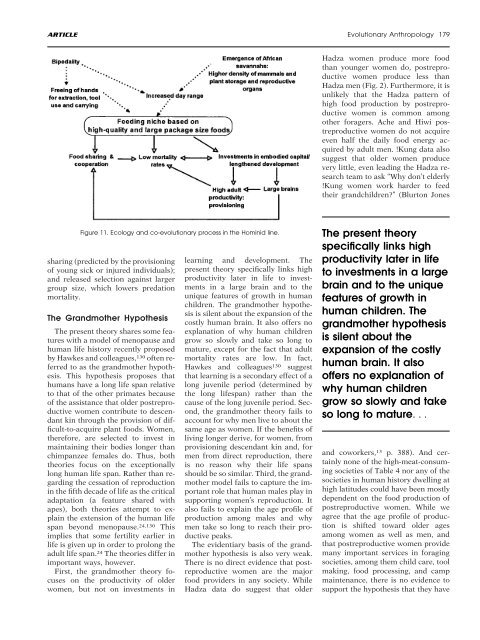A Theory of Human Life History Evolution - Radical Anthropology ...
A Theory of Human Life History Evolution - Radical Anthropology ...
A Theory of Human Life History Evolution - Radical Anthropology ...
Create successful ePaper yourself
Turn your PDF publications into a flip-book with our unique Google optimized e-Paper software.
ARTICLE <strong>Evolution</strong>ary <strong>Anthropology</strong> 179<br />
Hadza women produce more food<br />
than younger women do, postreproductive<br />
women produce less than<br />
Hadza men (Fig. 2). Furthermore, it is<br />
unlikely that the Hadza pattern <strong>of</strong><br />
high food production by postreproductive<br />
women is common among<br />
other foragers. Ache and Hiwi postreproductive<br />
women do not acquire<br />
even half the daily food energy acquired<br />
by adult men. !Kung data also<br />
suggest that older women produce<br />
very little, even leading the Hadza research<br />
team to ask “Why don’t elderly<br />
!Kung women work harder to feed<br />
their grandchildren?” (Blurton Jones<br />
Figure 11. Ecology and co-evolutionary process in the Hominid line.<br />
sharing (predicted by the provisioning<br />
<strong>of</strong> young sick or injured individuals);<br />
and released selection against larger<br />
group size, which lowers predation<br />
mortality.<br />
The Grandmother Hypothesis<br />
The present theory shares some features<br />
with a model <strong>of</strong> menopause and<br />
human life history recently proposed<br />
by Hawkes and colleagues, 130 <strong>of</strong>ten referred<br />
to as the grandmother hypothesis.<br />
This hypothesis proposes that<br />
humans have a long life span relative<br />
to that <strong>of</strong> the other primates because<br />
<strong>of</strong> the assistance that older postreproductive<br />
women contribute to descendant<br />
kin through the provision <strong>of</strong> difficult-to-acquire<br />
plant foods. Women,<br />
therefore, are selected to invest in<br />
maintaining their bodies longer than<br />
chimpanzee females do. Thus, both<br />
theories focus on the exceptionally<br />
long human life span. Rather than regarding<br />
the cessation <strong>of</strong> reproduction<br />
in the fifth decade <strong>of</strong> life as the critical<br />
adaptation (a feature shared with<br />
apes), both theories attempt to explain<br />
the extension <strong>of</strong> the human life<br />
span beyond menopause. 24,130 This<br />
implies that some fertility earlier in<br />
life is given up in order to prolong the<br />
adult life span. 24 The theories differ in<br />
important ways, however.<br />
First, the grandmother theory focuses<br />
on the productivity <strong>of</strong> older<br />
women, but not on investments in<br />
learning and development. The<br />
present theory specifically links high<br />
productivity later in life to investments<br />
in a large brain and to the<br />
unique features <strong>of</strong> growth in human<br />
children. The grandmother hypothesis<br />
is silent about the expansion <strong>of</strong> the<br />
costly human brain. It also <strong>of</strong>fers no<br />
explanation <strong>of</strong> why human children<br />
grow so slowly and take so long to<br />
mature, except for the fact that adult<br />
mortality rates are low. In fact,<br />
Hawkes and colleagues 130 suggest<br />
that learning is a secondary effect <strong>of</strong> a<br />
long juvenile period (determined by<br />
the long lifespan) rather than the<br />
cause <strong>of</strong> the long juvenile period. Second,<br />
the grandmother theory fails to<br />
account for why men live to about the<br />
same age as women. If the benefits <strong>of</strong><br />
living longer derive, for women, from<br />
provisioning descendant kin and, for<br />
men from direct reproduction, there<br />
is no reason why their life spans<br />
should be so similar. Third, the grandmother<br />
model fails to capture the important<br />
role that human males play in<br />
supporting women’s reproduction. It<br />
also fails to explain the age pr<strong>of</strong>ile <strong>of</strong><br />
production among males and why<br />
men take so long to reach their productive<br />
peaks.<br />
The evidentiary basis <strong>of</strong> the grandmother<br />
hypothesis is also very weak.<br />
There is no direct evidence that postreproductive<br />
women are the major<br />
food providers in any society. While<br />
Hadza data do suggest that older<br />
The present theory<br />
specifically links high<br />
productivity later in life<br />
to investments in a large<br />
brain and to the unique<br />
features <strong>of</strong> growth in<br />
human children. The<br />
grandmother hypothesis<br />
is silent about the<br />
expansion <strong>of</strong> the costly<br />
human brain. It also<br />
<strong>of</strong>fers no explanation <strong>of</strong><br />
why human children<br />
grow so slowly and take<br />
so long to mature. ..<br />
and coworkers, 13 p. 388). And certainly<br />
none <strong>of</strong> the high-meat-consuming<br />
societies <strong>of</strong> Table 4 nor any <strong>of</strong> the<br />
societies in human history dwelling at<br />
high latitudes could have been mostly<br />
dependent on the food production <strong>of</strong><br />
postreproductive women. While we<br />
agree that the age pr<strong>of</strong>ile <strong>of</strong> production<br />
is shifted toward older ages<br />
among women as well as men, and<br />
that postreproductive women provide<br />
many important services in foraging<br />
societies, among them child care, tool<br />
making, food processing, and camp<br />
maintenance, there is no evidence to<br />
support the hypothesis that they have
















